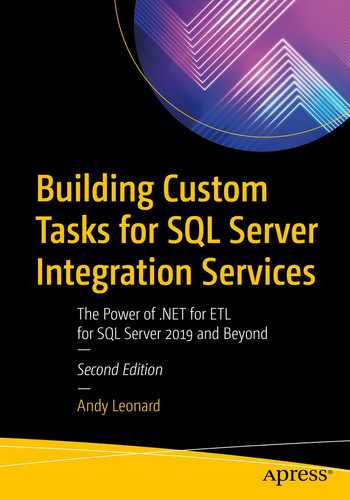In previous chapters, we’ve coded features for the version of the Execute Catalog Package Task built in this second edition of the book. It’s now time to test the Execute Catalog Package Task.
Manually Testing Use Cases
Test frameworks that automate redundancies in test generation, execution, and reporting exist. If your job is developing software all day every day, you either know about test frameworks or you will. You will occasionally encounter a testing requirement for which your chosen test framework is either incapable or “clunky.” In that case, you will need to build a manual test.
All good testing is a series of scenarios, expected answers or results (assertions), and measurement of the actual results. The combination of a scenario and assertion is referred to as a use case. A single use case may contain several assertions. When we perform testing, we work through each use case, measure results, and record the measurements.

Andy’s software testing maxim
Software testing is meticulous and demanding work. We test some, not all, use cases in this chapter. If we tested all use cases, this chapter would be 150 pages, and my editor would (rightly) point out that this is a chapter, not a test plan.
Use Cases
- 1.
Task existence
- 2.
Task validation
- 3.
Task Editor – General
The first few use cases involve visual inspection – simply checking to see if the Execute Catalog Package Task appears in the SSIS Toolbox and, if so, selecting the Execute Catalog Package Task in the SSIS Toolbox and verifying the toolbox description.
The tests are documented using a manual testing documentation format. The author has seen similar manual testing documentation presented in an Excel spreadsheet and prefers Word documentation for manual test documentation.
Testing Task Existence

Does the Execute Catalog Package Task appear in the SSIS Toolbox?
Assertion: The Execute Catalog Package Task appears in the SSIS Toolbox.
Measurement: True.
Assertion: When the Execute Catalog Package Task is selected in the SSIS Toolbox, the Execute Catalog Package Task description appears in the Information portion of the SSIS Toolbox.
Measurement: True.
Testing Task Validation
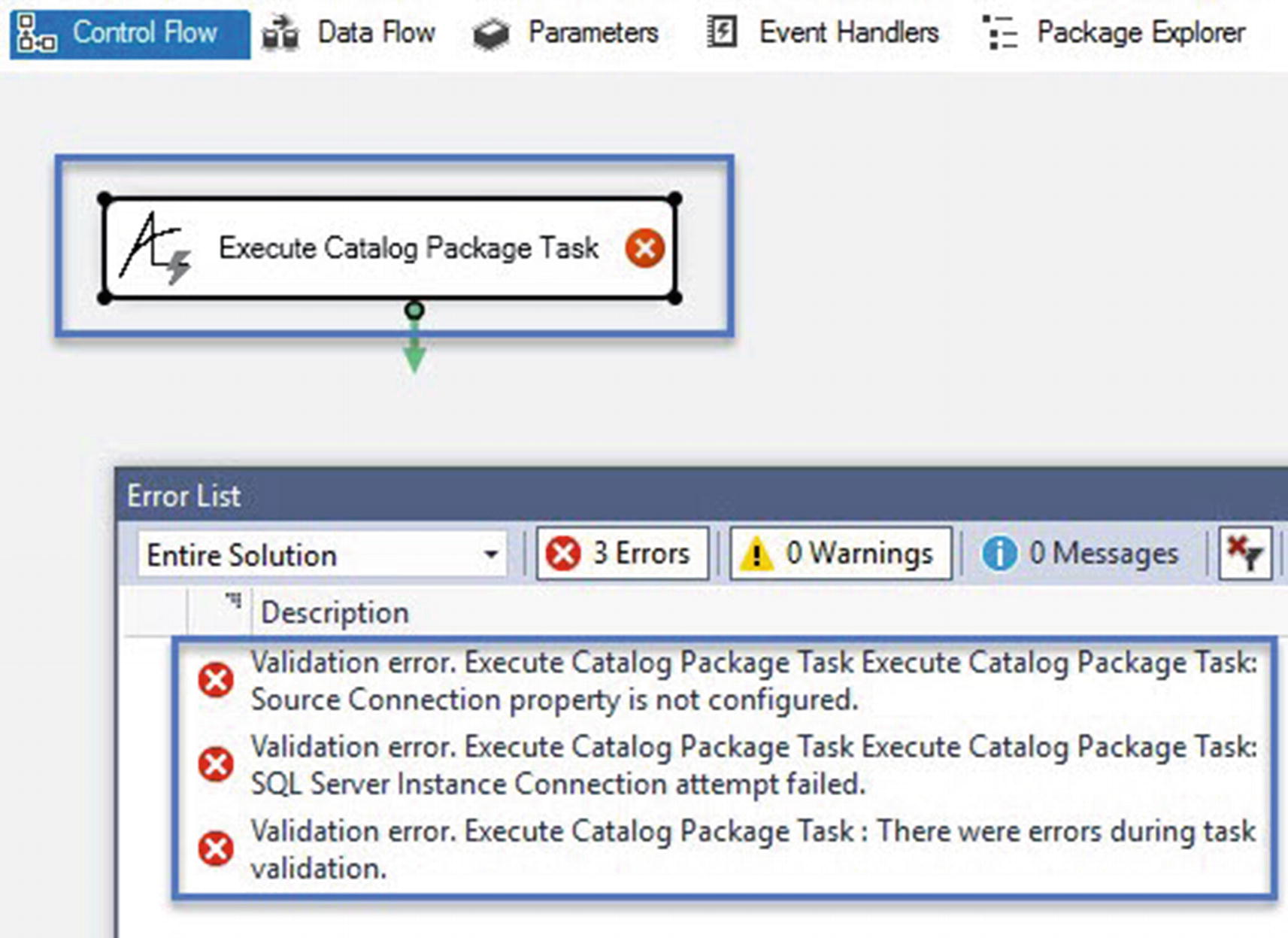
Does the Execute Catalog Package Task appear – in error – on the Control Flow canvas?
Assertion: An Execute Catalog Package Task may be added to the Control Flow canvas of a test SSIS package.
Measurement: True.
Assertion: A newly added Execute Catalog Package Task raises validation errors.
Measurement: True.
Source Connection property is not properly configured.
SQL Server Instance Connection attempt failed.
Measurement: True.
There were errors during the task validation.
Measurement: True.
Testing the Task Editor
In the following test sections, we exercise the Execute Catalog Package Task Editor. Appearance and function are tested.

Does the Execute Catalog Package Task Editor display without error?
Sometimes the solution build succeeds, and one (or more than one) value is misaligned between the ExecuteCatalogPackageTask and ExecuteCatalogPackageTaskComplexUI classes. When such misalignment occurs, the editor will not display. Instead, an error will display.
Assertion: The Execute Catalog Package Task Editor opens without error.
Measurement: True, the Execute Catalog Package Task Editor opens without error.
- 1.
General
- 2.
Settings
- 3.
Expressions
Measurement: True.
Assertion: The General View displays when the Execute Catalog Package Task Editor first opens.
Measurement: True.
Assertion: The General View displays the Execute Catalog Package Task Name and Description properties, and the property values are editable.
Measurement: True.

Does the Execute Catalog Package Task Editor SettingsView display without error?
Assertion: The Settings View displays without error when Settings is selected.
Measurement: True.
- Connections
SourceConnection
- SSIS Catalog Package Properties
Folder
Project
Package
- SSIS Package Execution Properties
Use32bit
LoggingLevel
- SSIS Package Synchronized Properties
Synchronized
MaximumRetries
RetryIntervalSeconds
OperationTimeoutMinutes
Measurement: True

Does the SourceConnection dropdown list display all available ADO.Net connection managers without error?
Assertion: The SourceConnection dropdown list displays all available ADO.Net connection managers without error.
Measurement: True.

Selecting a value for the SourceConnection property
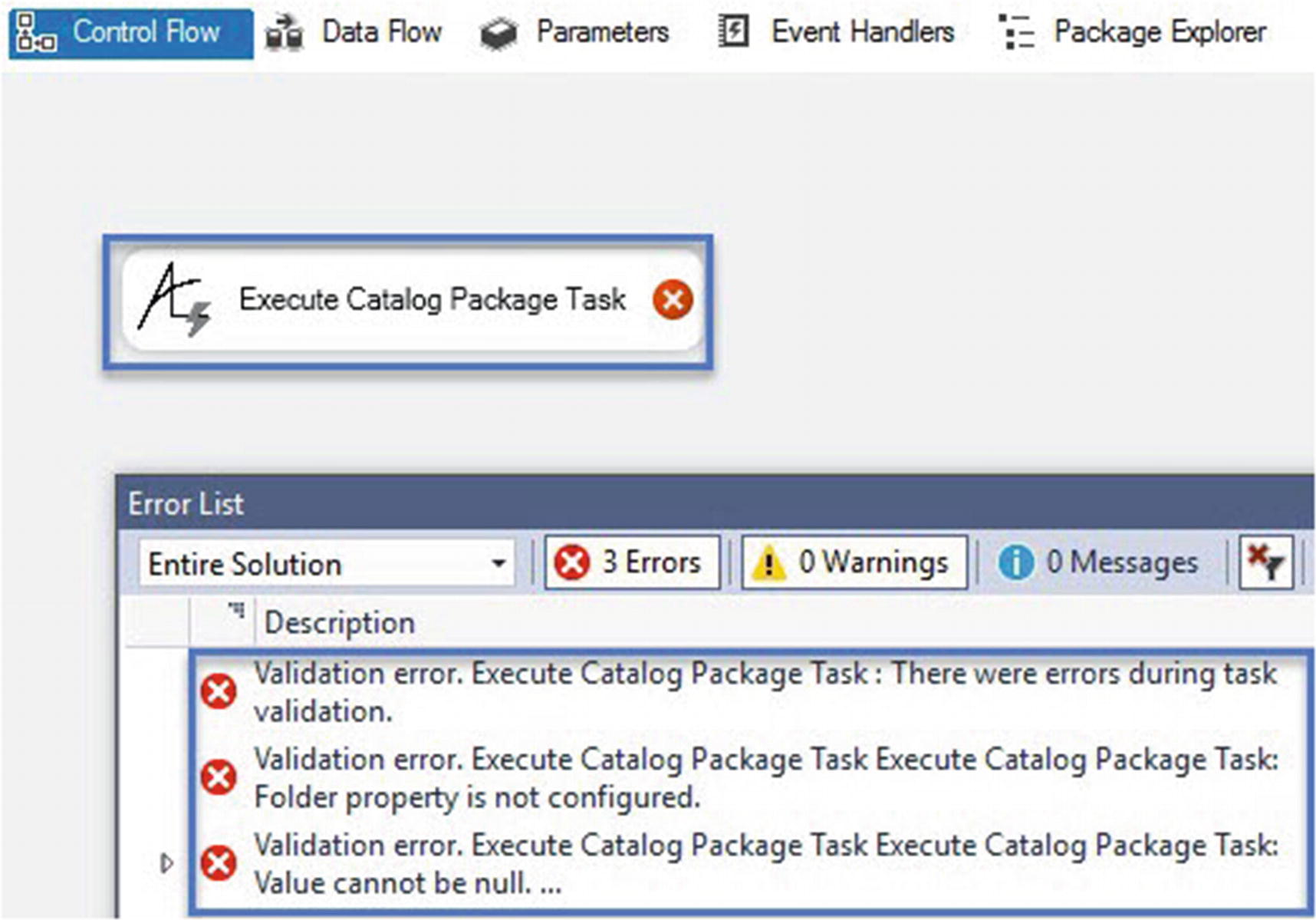
Does the Execute Catalog Package Task appear – in error – on the Control Flow canvas?
There were errors during the task validation.
Folder property is not properly configured.
Value cannot be null.
Measurement: True.
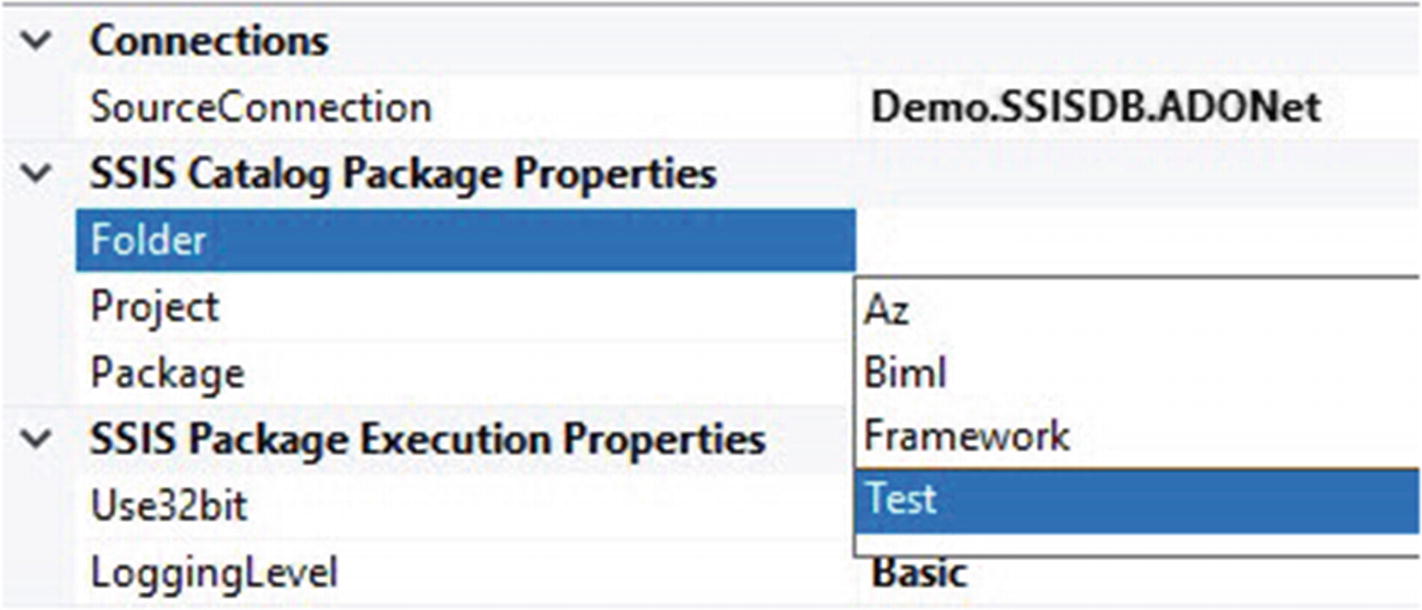
Does the Folder dropdown list display all available folders in the SSIS Catalog configured in the SourceConnection without error?

Obtain the SQL Server instance from the SourceConnection connection manager

Observing SSIS Catalog folders
The SSIS Catalog folders shown in Figure 21-11 match the list of SSIS Catalog folders shown in Figure 21-9.
Measurement: True.

Selecting a value for the Folder property

Does the Execute Catalog Package Task appear – in error – on the Control Flow canvas?
There were errors during the task validation.
Value cannot be null.
Project property is not properly configured.
Measurement: True.
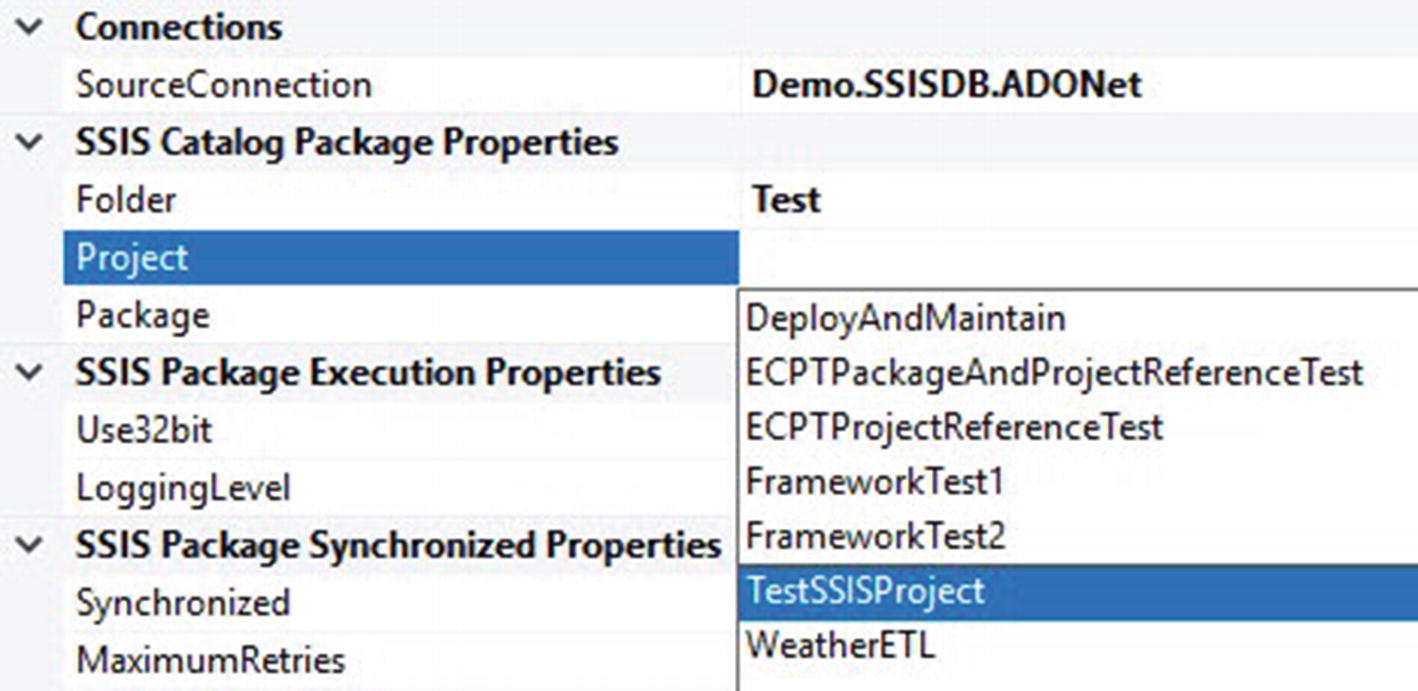
Does the Project dropdown list display all available projects in the SSIS Catalog folder configured in the Folder property without error?

Observing SSIS Catalog projects in the configured SSIS folder
The SSIS Catalog projects shown in Figure 21-15 match the list of SSIS Catalog projects shown in Figure 21-14.
Measurement: True.

Selecting a value for the Project property

Does the Execute Catalog Package Task appear – in error – on the Control Flow canvas?
There were errors during the task validation.
Value cannot be null.
Package property is not properly configured.
Measurement: True.
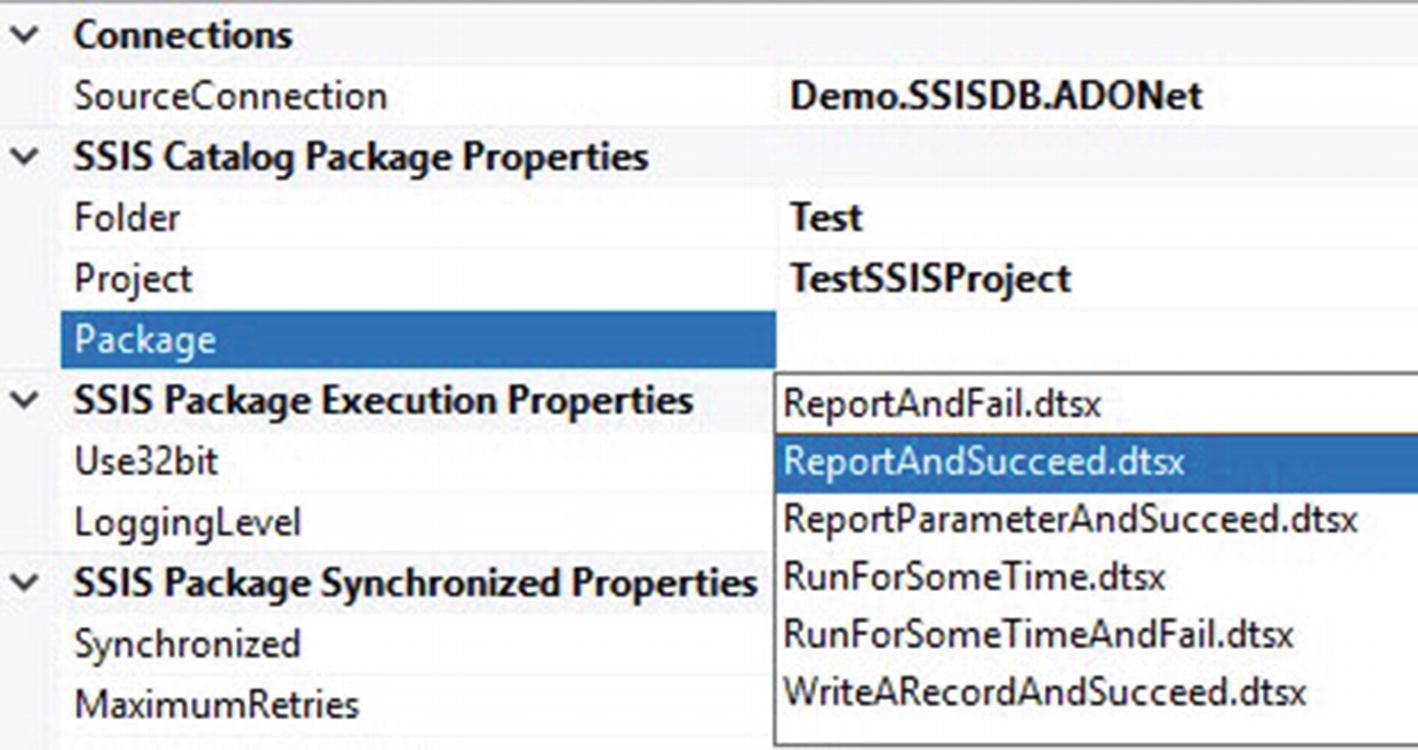
Does the Package dropdown list display all available packages in the SSIS Catalog project configured in the Project property without error?

Observing SSIS Catalog packages in the configured SSIS project
The SSIS Catalog packages shown in Figure 21-19 match the list of SSIS Catalog projects shown in Figure 21-18.
Measurement: True.

The Execute Catalog Package Task, minimally configured to pass validation
Assertion: No validation errors are raised by the Execute Catalog Package Task as currently configured.
Measurement: True.
Testing Execution
We shift gears at this point in the test process. While I dearly love manual software testing and documenting test results in “test-speak” for posterity, not everyone shares my passion. Starting here, we switch to prose.

The Execute Catalog Package Task, as configured
The current configuration tests asynchronous SSIS package execution because the Synchronized property – which maps to the SSIS Catalog execution parameter – is set to false, which is the default.

A successful test execution

Validating events

Preparing to test synchronized execution

Another successful test execution

Asynchronous execution event messages: check

Preparing to test synchronized execution of an SSIS package built to fail

A failed execution, as expected

Synchronous execution event messages, check

Preparing to test a non-synchronized execution of an SSIS package built to fail

A successful execution of a package, or is it?

Asynchronous execution instrumentation events
Examine the SSIS Catalog All Executions Report.

Configuring a longer-running synchronous SSIS package execution

Yet another successful execution

Event messages for a synchronous execution of a longer-running execution
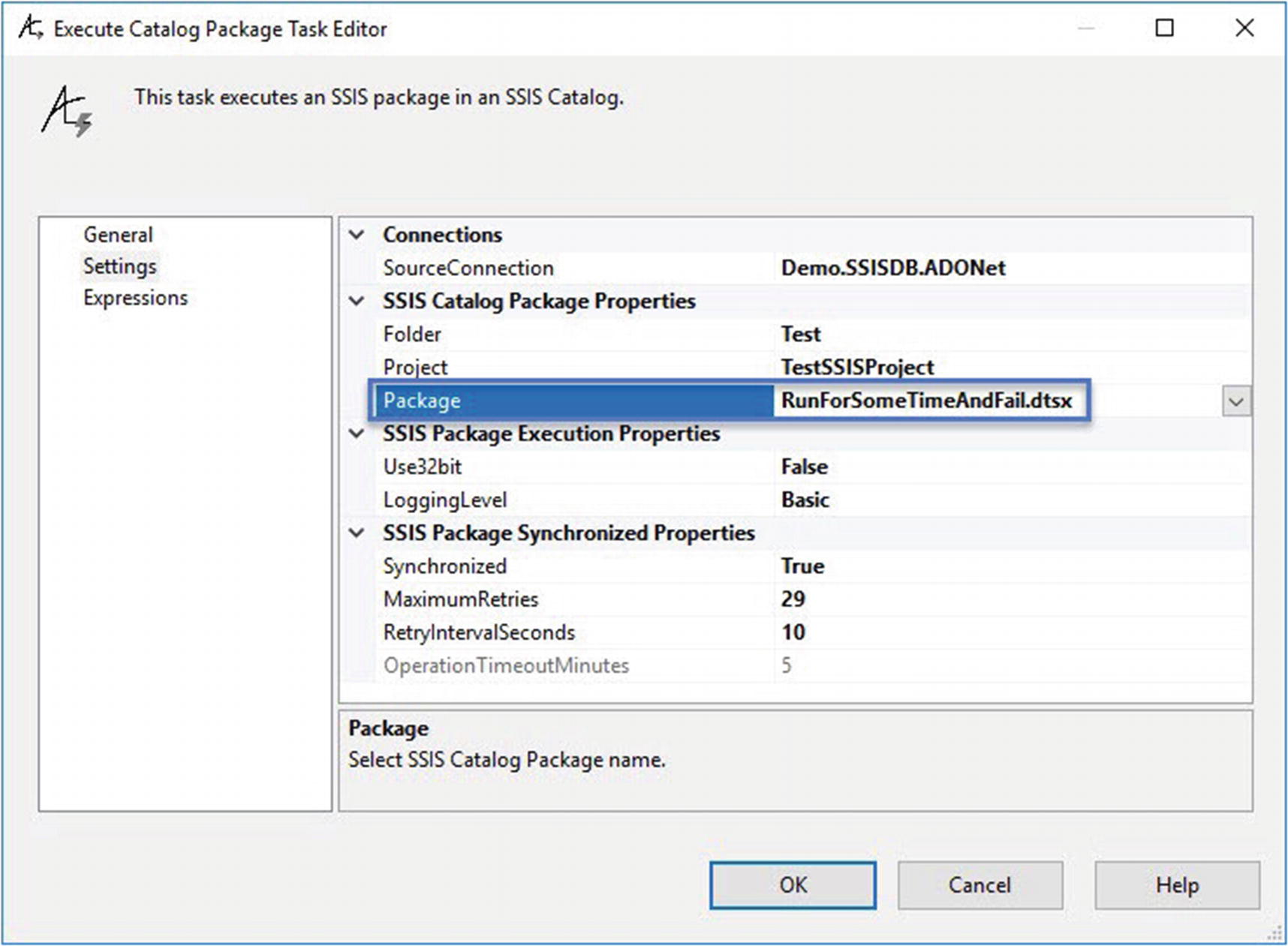
Configuring a longer-running synchronous SSIS package built to fail

A failed execution, as expected

Synchronous failed execution instrumentation events

Preparing to test a non-synchronized execution of the same SSIS package built to fail

A successful execution

Testing MaximumRetries

A failed execution, as expected

The SSIS Package execution was canceled

The SSIS package execution status in the SSIS Catalog
If all goes according to plan, the All Executions SSIS Catalog report in SSMS should indicate the SSIS package execution was canceled.
Conclusion
In this chapter, we applied one manual testing technique for testing validation and then tested the Execute Catalog Package Task execution functionality.
The next step is to build an installer file to ease propagation of the Execute Catalog Package Task in an enterprise.
Now would be an excellent time to check in your code.
